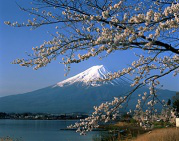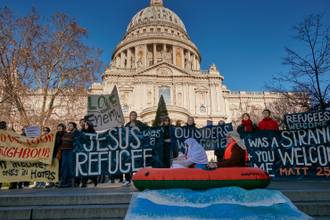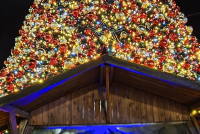Japan is struck by disaster - Catholic diocese first victim of quake

Mount Fuji with cherry blossom - ICN
It has been the largest earthquake ever to have hit Japan. As the tsunami caused by the offshore megaquake struck the coast, it has the potential to be more widespread and devastating than if it had occurred inland. Incredible images of tsunami waters forging their way relentlessly inland do not show the number of unsuspecting individuals who were caught in its path. Televisions across the world have shown images of large fishing boats rocked, overturned and capsized as they struck buses, lorries and bridges. Walls and buildings collapsed in towns and cities designed to withstand the earth tremors which Japan constantly experiences. At the time of writing, the death toll is completely unknown. Even the greatest experts of the world's seismologists admit that nobody could have been prepared for the disaster. The US Geological survey described the earthquake of 10 March as 'one of the great earthquakes' in history.
Measuring 8.9 on the Richter scale, its effects could reach across the entire Pacific coast, affecting countries as distant as Chile. Warnings to Pacific islands urged that coastal areas be evacuated. Some islands will be hit by waves higher than their own highest areas. Even Canada, Alaska and California issued tsunami alerts.
The Catholic diocese of Sendai was the first victim of Japan's tsunami following the earthquake. Covering a land area of 27864 square miles, the diocesan territory includes the cities of Aomori, Iwate, Miyagi and Fukushima. Initial reports suggest that Miyagi and Fukushima were the first to fall victim to the 33ft tsunami caused by the megaquake. In Sendai, where a major oil terminal exploded when its cooling system failed, Catholics form 0.15% of the total population of 7,207,624. In Tokyo Catholics are 0.51% of a total population of 18,552,995 people. In both cities, the predominant religions are Shinto and Buddhism.
There are approximately 509,000 Catholics in Japan, of whom 10,944 are in the diocese of Sendai and a further 95,877 in the archdiocese of Tokyo, which also felt the force of the earthquake even though it is situated more than 250 miles from its epicentre.
Although relatively small, the Japanese Church is vibrant, perhaps nurtured by the seed of its many thousands of martyrs during the 500 years of its history of Christianity. As a result of a period of persecution which lasted from 1614 until 1858, Japan apparently has the world's greatest number of Catholic martyrs. In the 17th century alone, it is estimated that there were between 200,000 and 300,000 martyrs. The most famous were the 55 who were executed in Nagasaki on 10 September 1632. After 1632, so many died for their faith, often accompanied by excruciating and virtually unimaginable torture, that it became impossible to collect all their data.
In spite of the importance of the Japanese economy to the world at large, the country's wealth does not always filter down to the Catholic Church. Japan is proof that a country does not to be poor and part of the developing world to be grouped amongst those that need support from Missio-worldwide. Yet, through Missio-Japan, Japanese Catholics contribute approximately £600,000 annually to help the Church in places where people are in greater need.
Missio is not an emergency aid organisation: its purpose is to be present 'for the long haul' in the Church wherever it is young or poor. It is impossible within a few hours of the initial earthquake to know what the needs are and where they should be directed. 'At the moment, all we can do is to pray', declared Mgr John Dale, the National Director of Missio-England and Wales. 'When we know more, we can do more.'
On 22 February, the earthquake that hit Christchurch in New Zealand initiated a campaign of prayer amongst the 150 countries in which Missio is represented. Fr Paul Shannahan SMA, the National Director of Missio-New Zealand remarked at the time that 'The biggest 'damage' is to people. Many were traumatised in the 7.1 quake last September but this one is worse in that it was in the middle of a working and school day. It hit with such vigour. It shook whole building violently. Hundreds have sustained injuries but shock and fear is scaring them even more. Thousands are trying to get home and many more are leaving the city to stay elsewhere.'
The effects on Japan and the Pacific will be considerably greater. We offer our prayers and the promise of future support.
Source: MISSIO


















